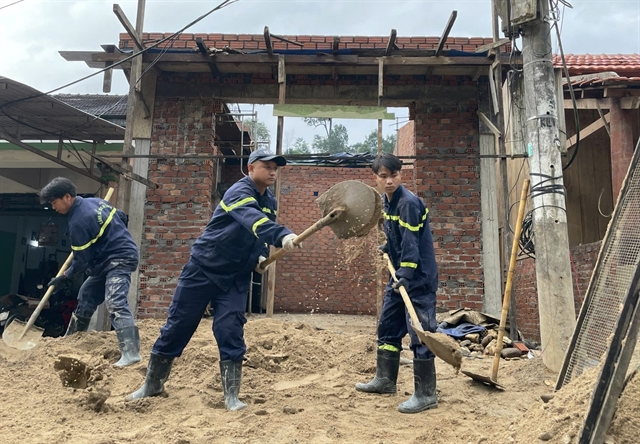 Society
Society


|
| Háng Pu Xi Village in Điện Biên Province's Xa Dung Commune recently suffered serious landslides and flash floods. VNA/VNS Photo |
HÀ NỘI The Ministry of Agriculture and Environment has submitted to Deputy Prime Minister Trần Hồng Hà a proposal for a comprehensive project focused on preventing and controlling landslides and flash floods in central and northern provinces.
The project is designed to address the increasingly severe natural disasters driven by climate change, and is expected to be implemented across 22 provinces and cities nationwide.
Its primary goals are to minimise human and property losses and to ensure sustainable socio-economic development in vulnerable regions.
Due to the impact of climate change, in recent years, natural disasters have become increasingly intense and widespread, with effects reaching many provinces and cities across the country.
Landslides and flash floods are particularly dangerous and destructive natural disasters that frequently occur during the annual rainy season in the mountainous central and northern regions, causing serious damage to people's lives and property.
From 2020 to 2025, many serious landslides have caused severe losses, including a landslide at the Rào Trăng 3 Hydropower Plant in former Thừa Thiên-Huế Province, the burial of the Sub-region 67 Forest Ranger Station, a landslide in Quảng Nam Province's Trà Leng Commune, and flash floods and landslides that killed hundreds of people in the mountainous Central Highlands and northern areas after Typhoon Yagi hit in 2024.
The project proposal was based on data collected from 35 provinces and consultations with both Vietnamese and foreign experts.
Starting in January, the ministry has issued an action programme and collected feedback from ministries, sectors and localities. To date, most relevant agencies have submitted comments, forming a basis to finalise the draft proposal for submission to the Government.
The overall goals of the project are to minimise damage caused by landslides and flash floods, ensure public safety and enhance disaster prevention and climate change adaptation measures.
Under the project, by 2030, all provinces in risk-prone areas will have completed zoning maps at a scale of 1:50,000, with key communes mapped at 1:10,000. Meanwhile, modern early warning systems will cover high-risk areas.
By 2035, over 95 per cent of monitoring systems will be automated, and disaster prevention infrastructure will be comprehensively funded.
The project is expected to be implemented between 2025–2035, covering provinces and cities in central Việt Nam and mountainous northern regions, including Điện Biên, Lai Châu, Sơn La, Lào Cai, Lạng Sơn, Cao Bằng, Tuyên Quang, Quảng Ninh, Bắc Ninh, Thái Nguyên, Phú Thọ, Thanh Hóa, Nghệ An, Hà Tĩnh, Quảng Trị, Huế, Đà Nẵng, Quảng Ngãi, Khánh Hòa, Lâm Đồng, Gia Lai and Đắk Lắk.
Targets include activities by agencies, organisations and individuals related to the prevention of landslides and flash floods caused by heavy rains and runoff.
Key solutions include reviewing and improving policies and legal frameworks; creating detailed risk maps for landslides and flash floods; modernising early warning and monitoring systems; relocating residents from hazardous areas; developing upstream forests; and applying modern technology like artificial intelligence (AI) and the Internet of Things (IoT).
The total projected budget is VNĐ161 trillion (US$6.1 billion), sourced from the State Budget, the Disaster Prevention Fund and social mobilisation.
The Ministry of Agriculture and Environment will take the lead in coordination, mapping, legal framework improvements and system operation.
Other ministries, including Finance, Construction, Defence and Science and Technology, will provide financing, planning, training and technical support.
People’s Committees of provinces and cities are responsible for local investigation, resettlement and implementation of disaster prevention efforts.
This proposal is considered a significant step towards fulfilling Resolution 01/NQ-CP on modernising hydrometeorological systems and improving the national capacity for climate change response, one of today’s most pressing challenges. VNS




